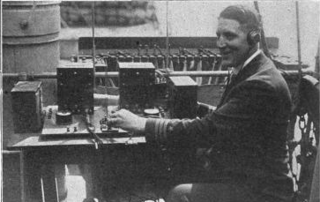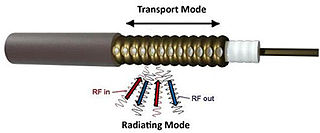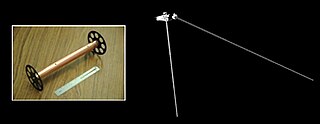Related Research Articles

Radio waves are a type of electromagnetic radiation with the lowest frequencies and the longest wavelengths in the electromagnetic spectrum, typically with frequencies below 300 gigahertz (GHz) and wavelengths greater than 1 millimeter, about the diameter of a grain of rice. Radio waves with frequencies above about 1 GHz and wavelengths shorter than 30 centimeters are called microwaves. Like all electromagnetic waves, radio waves in a vacuum travel at the speed of light, and in the Earth's atmosphere at a slightly lower speed. Radio waves are generated by charged particles undergoing acceleration, such as time-varying electric currents. Naturally occurring radio waves are emitted by lightning and astronomical objects, and are part of the blackbody radiation emitted by all warm objects.

Very low frequency or VLF is the ITU designation for radio frequencies (RF) in the range of 3–30 kHz, corresponding to wavelengths from 100 to 10 km, respectively. The band is also known as the myriameter band or myriameter wave as the wavelengths range from one to ten myriameters. Due to its limited bandwidth, audio (voice) transmission is highly impractical in this band, and therefore only low data rate coded signals are used. The VLF band is used for a few radio navigation services, government time radio stations and for secure military communication. Since VLF waves can penetrate at least 40 meters (131 ft) into saltwater, they are used for military communication with submarines.
Low frequency (LF) is the ITU designation for radio frequencies (RF) in the range of 30–300 kHz. Since its wavelengths range from 10–1 km, respectively, it is also known as the kilometre band or kilometre waves.

Medium frequency (MF) is the ITU designation for radio frequencies (RF) in the range of 300 kilohertz (kHz) to 3 megahertz (MHz). Part of this band is the medium wave (MW) AM broadcast band. The MF band is also known as the hectometer band as the wavelengths range from ten to one hectometers. Frequencies immediately below MF are denoted as low frequency (LF), while the first band of higher frequencies is known as high frequency (HF). MF is mostly used for AM radio broadcasting, navigational radio beacons, maritime ship-to-shore communication, and transoceanic air traffic control.

A whistler is a very low frequency (VLF) electromagnetic (radio) wave generated by lightning. Frequencies of terrestrial whistlers are 1 kHz to 30 kHz, with maximum frequencies usually at 3 kHz to 5 kHz. Although they are electromagnetic waves, they occur at audio frequencies, and can be converted to audio using a suitable receiver. They are produced by lightning strikes where the impulse travels along the Earth's magnetic field lines from one hemisphere to the other. They undergo dispersion of several kHz due to the slower velocity of the lower frequencies through the plasma environments of the ionosphere and magnetosphere. Thus they are perceived as a descending tone which can last for a few seconds. The study of whistlers categorizes them into Pure Note, Diffuse, 2-Hop, and Echo Train types.

High frequency (HF) is the ITU designation for the band of radio waves with frequency between 3 and 30 megahertz (MHz). It is also known as the decameter band or decameter wave as its wavelengths range from one to ten decameters. Frequencies immediately below HF are denoted medium frequency (MF), while the next band of higher frequencies is known as the very high frequency (VHF) band. The HF band is a major part of the shortwave band of frequencies, so communication at these frequencies is often called shortwave radio. Because radio waves in this band can be reflected back to Earth by the ionosphere layer in the atmosphere – a method known as "skip" or "skywave" propagation – these frequencies can be used for long-distance communication across intercontinental distances and for mountainous terrains which prevent line-of-sight communications. The band is used by international shortwave broadcasting stations (3.95–25.82 MHz), aviation communication, government time stations, weather stations, amateur radio and citizens band services, among other uses.
Radio propagation is the behavior of radio waves as they travel, or are propagated, from one point to another in vacuum, or into various parts of the atmosphere. As a form of electromagnetic radiation, like light waves, radio waves are affected by the phenomena of reflection, refraction, diffraction, absorption, polarization, and scattering. Understanding the effects of varying conditions on radio propagation has many practical applications, from choosing frequencies for amateur radio communications, international shortwave broadcasters, to designing reliable mobile telephone systems, to radio navigation, to operation of radar systems.

Extremely low frequency (ELF) is the ITU designation for electromagnetic radiation with frequencies from 3 to 30 Hz, and corresponding wavelengths of 100,000 to 10,000 kilometers, respectively. In atmospheric science, an alternative definition is usually given, from 3 Hz to 3 kHz. In the related magnetosphere science, the lower-frequency electromagnetic oscillations are considered to lie in the ULF range, which is thus also defined differently from the ITU radio bands.

Ultra low frequency (ULF) is the ITU designation for the frequency range of electromagnetic waves between 300 hertz and 3 kilohertz, corresponding to wavelengths between 1,000 to 100 km. In magnetosphere science and seismology, alternative definitions are usually given, including ranges from 1 mHz to 100 Hz, 1 mHz to 1 Hz, and 10 mHz to 10 Hz.
Super low frequency (SLF) is the ITU designation for electromagnetic waves in the frequency range between 30 hertz and 300 hertz. They have corresponding wavelengths of 10,000 to 1,000 kilometers. This frequency range includes the frequencies of AC power grids. Another conflicting designation which includes this frequency range is Extremely Low Frequency (ELF), which in some contexts refers to all frequencies up to 300 hertz.
Communication with submarines is a field within military communications that presents technical challenges and requires specialized technology. Because radio waves do not travel well through good electrical conductors like salt water, submerged submarines are cut off from radio communication with their command authorities at ordinary radio frequencies. Submarines can surface and raise an antenna above the sea level, or float a tethered buoy carrying an antenna, then use ordinary radio transmissions; however, this makes them vulnerable to detection by anti-submarine warfare forces.

Rugby Radio Station was a large British government radio transmission facility just east of the Hillmorton area of the town of Rugby, Warwickshire in England. The site straddled the A5 trunk road, with most of it in Warwickshire, and part on the other side of the A5 in Northamptonshire. First opened in 1926, at its height in the 1950s it was the largest radio transmitting station in the world, with a total of 57 radio transmitters, covering an area of 1,600 acres (650 ha). Traffic slowly dwindled from the 1980s onwards, and the site was closed between 2003 and 2007.

Grimeton Radio Station in southern Sweden, close to Varberg in Halland, is an early longwave transatlantic wireless telegraphy station built in 1922–1924, that has been preserved as a historical site. From the 1920s through the 1940s it was used to transmit telegram traffic by Morse code to North America and other countries, and during World War II was Sweden's only telecommunication link with the rest of the world. It is the only remaining example of an early pre-electronic radio transmitter technology called an Alexanderson alternator. It was added to the UNESCO World Heritage List in 2004, with the statement: "Grimeton Radio Station, Varberg is an exceptionally well preserved example of a type of telecommunication centre, representing the technological achievements by the early 1920s, as well as documenting the further development over some three decades." The radio station is also an anchor site for the European Route of Industrial Heritage. The transmitter is still in operational condition, and each year on a day called Alexanderson Day is started up and transmits brief Morse code test transmissions, which can be received all over Europe.

A leaky feeder is a communications system used in underground mines and inside tunnels. Manufacturers and cabling professionals use the term "radiating cable" as this implies that the cable is designed to radiate: something that a typical coaxial cable is generally not intended to do.

2182 kHz is a radio frequency designed exclusively for distress calls and related calling operations in the maritime service. It is equivalent to a wavelength of 137.4 metres.

An umbrella antenna is a capacitively top-loaded wire monopole antenna, consisting in most cases of a mast fed at the ground end, to which a number of radial wires are connected at the top, sloping downwards. One side of the feedline supplying power from the transmitter is connected to the mast, and the other side to a ground (Earthing) system of radial wires buried in the earth under the antenna. They are used as transmitting antennas below 1 MHz, in the MF, LF and particularly the VLF bands, at frequencies sufficiently low that it is impractical or infeasible to build a full size quarter-wave monopole antenna. The outer end of each radial wire, sloping down from the top of the antenna, is connected by an insulator to a supporting rope or cable anchored to the ground; the radial wires can also support the mast as guy wires. The radial wires make the antenna look like the wire frame of a giant umbrella hence the name.

In radio communication, a ground dipole, also referred to as an earth dipole antenna, transmission line antenna, and in technical literature as a horizontal electric dipole (HED), is a huge, specialized type of radio antenna that radiates extremely low frequency (ELF) electromagnetic waves. It is the only type of transmitting antenna that can radiate practical amounts of power in the frequency range of 3 Hz to 3 kHz, commonly called ELF waves. A ground dipole consists of two ground electrodes buried in the earth, separated by tens to hundreds of kilometers, linked by overhead transmission lines to a power plant transmitter located between them. Alternating current electricity flows in a giant loop between the electrodes through the ground, radiating ELF waves, so the ground is part of the antenna. To be most effective, ground dipoles must be located over certain types of underground rock formations. The idea was proposed by U.S. Dept. of Defense physicist Nicholas Christofilos in 1959.

Radio is the technology of communicating using radio waves. Radio waves are electromagnetic waves of frequency between 3 hertz (Hz) and 300 gigahertz (GHz). They are generated by an electronic device called a transmitter connected to an antenna which radiates oscillating electrical energy, often characterized as a wave. They can be received by other antennas connected to a radio receiver, this is the fundamental principle of radio communication. In addition to communication, radio is used for radar, radio navigation, remote control, remote sensing, and other applications.

Project Sanguine was a US Navy project proposed in 1968 for communication with submerged submarines using extremely low frequency (ELF) radio waves. The initially proposed system, hardened to survive a nuclear attack, would have required a giant antenna covering two-fifths of the state of Wisconsin. The proposed approach was never implemented because of protests and potential environmental impact. A smaller, less hardened system called Project ELF consisting of two linked ELF transmitters located at Clam Lake, Wisconsin 46°05′05.6″N90°55′03.7″W and Republic, Michigan 46°20′10.1″N87°53′04.6″W was built beginning in 1982 and operated from 1989 until 2004. The system transmitted at a frequency of 76 Hz. At ELF frequencies, the bandwidth of the transmission was very small, so the system could only send short-coded text messages at a very low data rate. These signals were used to summon specific vessels to the surface to receive longer operational orders by ordinary radio or satellite communication.

Waves is an experiment on the Juno spacecraft for studying radio and plasma waves. It is part of a collection of various types of instruments and experiments on the spacecraft; Waves is oriented towards understanding fields and particles in the Jupiter's magnetosphere. Waves is on board the uncrewed Juno spacecraft, which was launched in 2011 and arrived at Jupiter in the summer of 2016. The major focus of study for Waves is Jupiter's magnetosphere, which if could be seen from Earth would be about twice the size of a full moon. The magnetosphere has a tear drop shape, and that tail extends away from the Sun by at least 5 AU. The Waves instrument is designed to help understand the interaction between Jupiter's atmosphere, its magnetic field, its magnetosphere, and to understand Jupiter's auroras. It is designed to detect radio frequencies from 50 Hz up to 40,000,000 Hz (40 MHz), and magnetic fields from 50 Hz to 20,000 Hz (20 kHz). It has two main sensors: a dipole antenna and a magnetic search coil. The dipole antenna has two whip antennas that extend 2.8 meters and are attached to the main body of the spacecraft. This sensor has been compared to a rabbit-ear TV antenna. The search coil is overall a Mu-metal rod 15 cm (6 in) in length with a fine copper wire wound 10,000 times around it. There are also two frequency receivers that each cover certain bands. Data handling is done by two radiation-hardened systems on a chip. The data handling units are located inside the Juno Radiation Vault. Waves is allocated 410 Mbits of data per science orbit.
References
- ↑ David Gibson, "Cave Radiolocation" ISBN 978-1-4457-7105-2
- ↑ Beford, Mike (2012). "A Directory of Cave Radio Designs". CREG Journal Archive.
- ↑ "HeyPhone Home Page". bcra.org.uk.
- ↑ Gibson, David (2010). Cave Radiolocation. Lulu.com. p. 73. ISBN 978-1445771052.
- ↑ "Systeme Nicola Mk2" (PDF).
- ↑ "Home". www.cavelink.com. Retrieved 2023-09-08.
- ↑ "VLF-Übermittlungssystem für die Höhlenforschung Cave-Link V2.1x" (PDF).
- ↑ "HeyPhone Introduction". bcra.org.uk. Retrieved 2020-01-14.
- ↑ "HeyPhone Documentation". bcra.org.uk. Retrieved 2020-01-14.
- ↑ "Communications Catalogue - ECRA - European Cave Rescue Association". 2023-04-25. Retrieved 2024-01-10.
- ↑ "Mine Safety and Health Administration (MSHA) - Emergency Communication and Tracking Committee - Underground Communication and Tracking Systems - Description of MSHA Approved Technologies" (PDF). US Mine Safety and Health Administration. 2007. Retrieved 2012-09-30.
- ↑ "Department of Mines and Energy - Moura No 4". Archived from the original on 2008-07-25. Retrieved 2009-01-20.
- ↑ "Department of Mines and Energy - Moura No 2". Archived from the original on 2008-07-25. Retrieved 2009-01-20.
- 1 2 "Underground Communication and Tracking Systems" (PDF). Archived from the original (PDF) on 2013-03-11. Retrieved 2012-02-07.
- ↑ "Willow Creek Mine Fire - A Chronology of Events". Archived from the original on 2009-01-17. Retrieved 2009-01-20.
- ↑ "Fire at Cyprus Plateau Mining Corporation's Willow Creek Mine". Archived from the original on 2017-08-03.
- ↑ "The Rescue Dog Emergency Communication System" (PDF). Archived from the original (PDF) on 2017-07-07.
- ↑ Unknown [ permanent dead link ]
- ↑ Rizzo, Johnna (May 2012). "Miner Lifeline". National Geographic. 221 (5): 37.
- ↑ "Maxtech Networks" . Retrieved 2020-09-27.
- ↑ Orr Hirschauge (2018-07-03). "Direct Radio Contact with Stranded Thai Group Still Unattained, Israeli Technology Vendor Says". Ctech. Retrieved 2020-09-27.
- ↑ "BATNODE – Sybet" (in Polish). 2023-08-30. Retrieved 2023-09-20.